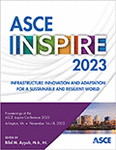Driving Factors of Rural Social Vulnerability for Communities at High Risk of Riverine Flooding in the United States
Publication: ASCE Inspire 2023
ABSTRACT
This paper examines the differences in factors of social vulnerability and flooding risk between rural and urban areas in the United States. Using data from the FEMA National Risk Index, US Census Bureau, CDC, and BRIC Community Resilience index, we analyze the relationship between overall riverine flood risk, social vulnerability, and community resilience and statistically significant differences are reported. Our findings show that rural counties with a high risk of riverine flooding have higher percentages of vulnerable populations, such as those living in poverty, without a high school diploma, over 65 years old, with disabilities, and living in mobile homes, compared to their urban counterparts. The work presents a timely and significant contribution to the field and provides a comprehensive snapshot of the national differences in community risk associated with flooding between rural and urban areas in the United States.
Get full access to this article
View all available purchase options and get full access to this chapter.
REFERENCES
Balica, S. F., N. G. Wright, and F. van der Meulen. 2012.“A flood vulnerability index for coastal cities and its use in assessing climate change impacts.” Nat Hazards, 64 (1): 73–105.
Balica, S., and N. G. Wright. 2009. “A network of knowledge on applying an indicator-based methodology for minimizing flood vulnerability.” Hydrological Processes, 23 (20): 2983–2986.
Birkmann, J. 2013. “Measuring Vulnerability to Natural Hazards: Towards Disaster Resilient Societies Second Edition - United Nations University.” Accessed April 16, 2023.
Birkmann, J., T. Welle, W. Solecki, S. Lwasa, and M. Garschagen. 2016. “Boost resilience of small and mid-sized cities.” Nature, 537 (7622): 605–608. Nature Publishing Group.
Brooks, N., W. Neil Adger, and P. Mick Kelly. 2005. “The determinants of vulnerability and adaptive capacity at the national level and the implications for adaptation.” Global Environmental Change, Adaptation to Climate Change, 15 (2): 151–163.
Cross, J. A. 2001. “Megacities and small towns: different perspectives on hazard vulnerability.” Global Environmental Change Part B: Environmental Hazards, 3 (2): 63–80.
Cutter, S. L., K. D. Ash, and C. T. Emrich. 2014. “The geographies of community disaster resilience.” Global Environmental Change, 29: 65–77.
Cutter, S. L., and C. Finch. 2008. “Temporal and spatial changes in social vulnerability to natural hazards.” Proceedings of the National Academy of Sciences, 105 (7): 2301–2306.
FEMA. 2022. “National Risk Index” FEMA, https://www.hazards.fema.gov/nri (Apr. 20, 2023).
Jamshed, A., I. A. Rana, U. M. Mirza, and J. Birkmann. 2019. “Assessing relationship between vulnerability and capacity: An empirical study on rural flooding in Pakistan.” International Journal of Disaster Risk Reduction, 36: 101109.
Lavell, A., et al. 2012. “Climate change: New dimensions in disaster risk, exposure, vulnerability, and resilience.” Managing the Risks of Extreme Events and Disasters to Advance Climate Change Adaptation, 25–64. Cambridge University Press.
Montgomery, M. C., and J. Chakraborty. 2015. “Assessing the environmental justice consequences of flood risk: a case study in Miami, Florida.” Environ. Res. Lett., 10 (9): 095010. IOP Publishing.
Oulahen, G., L. Mortsch, K. Tang, and D. Harford. 2015. “Unequal Vulnerability to Flood Hazards: ‘Ground Truthing’ a Social Vulnerability Index of Five Municipalities in Metro Vancouver, Canada.” Annals of the Association of American Geographers, 105 (3): 473–495. Routledge.
Rhubart, D., and Y. Sun. 2021. “The social correlates of flood risk: variation along the US rural–urban continuum.” Popul Environ, 43 (2): 232–256.
Sorg, L., N. Medina, D. Feldmeyer, A. Sanchez, Z. Vojinovic, J. Birkmann, and A. Marchese. 2018. “Capturing the multifaceted phenomena of socioeconomic vulnerability.” Nat Hazards, 92 (1): 257–282.
Tate, E. 2012. “Social vulnerability indices: a comparative assessment using uncertainty and sensitivity analysis.” Nat Hazards, 63 (2): 325–347.
US Census Bureau. 2015. “Urban and Rural.” Census.gov. <https://www.census.gov/programs-surveys/geography/guidance/geo-areas/urban-rural.html>(Apr. 20, 2023).
Walker, G. 2011. Environmental Justice: Concepts, Evidence and Politics. London: Routledge.
Welle, T., and J. Birkmann. 2015. “The World Risk Index – An Approach to Assess Risk and Vulnerability on a Global Scale.” J. of Extr. Even., 02 (01): 1550003. World Scientific Publishing Co.
Wisner, B., P. Blaikie, T. Cannon, and I. Davis. 2004. At Risk: Natural Hazards, People’s Vulnerability and Disasters. Routledge.
Zhou, Y., N. Li, W. Wu, J. Wu, and P. Shi. 2014. “Local Spatial and Temporal Factors Influencing Population and Societal Vulnerability to Natural Disasters.” Risk Analysis, 34 (4): 614–639.
Zuzak, C., E. Goodenough, C. Stanton, M. Mowrer, A. Sheehan, B. Roberts, P. McGuire, and J. Rozelle. 2023. National Risk Index Technical Documentation. Federal Emergency Management Agency, Washington, DC. (FEMA NRI).
Zuzak, C., M. Mowrer, E. Goodenough, J. Burns, N. Ranalli, and J. Rozelle. 2022. “The national risk index: establishing a nationwide baseline for natural hazard risk in the US.” Nat Hazards, 114 (2): 2331–2355.
Information & Authors
Information
Published In
History
Published online: Nov 14, 2023
ASCE Technical Topics:
- Business management
- Disaster risk management
- Floods
- Geography
- Geomatics
- Hydrologic data
- Hydrologic engineering
- Hydrology
- Infrastructure
- Infrastructure resilience
- Infrastructure vulnerability
- Practice and Profession
- Risk management
- Rural areas
- Social factors
- Urban and regional development
- Urban areas
- Water and water resources
Authors
Metrics & Citations
Metrics
Citations
Download citation
If you have the appropriate software installed, you can download article citation data to the citation manager of your choice. Simply select your manager software from the list below and click Download.
